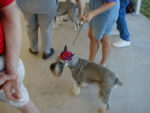Halloween Safety for Your Dog
Before you begin reading this page, write your veterinarian’s phone number and the 24/7/365 ASPCA Poison help line (888)426-4435 where you can find it again. When you’ve finished reading this page, make a copy of those phone numbers for every telephone in your home. Put a copy into the cell phone’s contacts directory for each of your family members (I have mine under “ICE Dog Emergency” along with my family’s emergency numbers).
Halloween can be a fun time for your family, but not necessarily for your family’s pets. In fact, Halloween can be deadly to pets.
COSTUMES:

One of today’s less attractive pet fads is dressing up your dog (or cat) in those cutesy Halloween costumes. Please resist the urge to outfit your dog as a ghost, a witch, or a chef. Avoid anything that causes him to stumble, get tangled up in yards of fabric, or choke from something you or your children tied around his neck. I once declined to place one of my Standard Schnauzer puppies with a family who showed me photos of their previous dogs decked out in holiday attire hat could entangle them. Your dog would much rather look like a dog than “Yoda” from the Star Wars saga. Instead of a costume, why not get him a Halloween-themed collar or a Halloween toy he can enjoy safely at home?
FOODS:
Halloween treats are not good for your dog; they could even kill him. Grapes and raisins contain toxins that can cause kidney failure. Chocolate, especially dark chocolate, also can kill your dog; chocolate comprises both caffeine and theobromine, which can seriously damage the nervous system, urinary system, and heart muscle. Beware of any baked goods made with nutmeg, which affects the nervous system. Especially watch out for candy or gum with xylitol as an ingredient; xylitol causes severe liver damage or death in dogs. If he goes trick-or-treating with your kids, make sure the children know not to share their loot with him–and why. It’s better, however, to keep him home so the kids don’t fall prey to his beseeching eyes and give him “just one” of the treats on his forbidden list.
FEARS:

Animals get stressed out when their routine is upset, just as humans do. Travel, dog shows, or parties will do it. The hustle and bustle of Halloween goblins and ghosties in strange costumes can scare your dog. The noise and commotion from trick-or-treaters may frighten him as well. Make sure your dog has a safe, quiet place with food and water so he can withdraw if the excitement becomes too much for him. Some people have had good luck calming their nervous dog with a Thunder Shirt, a calming shirt that works like swaddling on a baby http://amzn.to/2y6cH6h . My advice is to avoid tranquilizers because they sometimes exacerbate the nervous behavior you’re trying to avoid. Instead, you might try NaturVet’s Quiet Moments Plus Melatonin http://amzn.to/2yUMnLO. I’ve been pleased with all the NaturVet products I’ve tried, Friends and family say Quiet Moments also works well to calm their dogs before grooming sessions. My dogs think their NaturVet Digestive Enzymes Plus Probiotics http://amzn.to/2i7vHGM soft chews are a treat—they each get three chews plus a segment of an orange every morning.
GENERAL HAZARDS:
Often in the commotion surrounding a holiday such as Halloween, we forget to consider the needs of our dogs. Put those Halloween treats in sealed dog-proof containers, preferably containers that keep enticing aromas from tempting your dog. Avoid scented candles, particularly when unattended, both because of the often-poisonous ingredients and because of the fire hazard they represent if your dog should drag or knock them off the table. Liquid potpourris or sachets that smell like pumpkin pie or baking cookies, while pleasant to you, can cause heat and chemical burns and welts to your dog’s skin and oral damage if ingested. If you enjoy decorating for autumn, be sure whatever you put in your home is safe for your pet; be careful if you decorate with cornucopias and the like that the fruits and nuts are safe for your dog. No grapes, raisins, macadamia nuts, or other unsafe fruits.
If you have guests who smoke, ask them to do so outside, and impress upon them to be careful disposing of their cigarette or cigar butts. E-cigarettes are even more hazardous to pets (and you and your kids!)–they emit toxic fumes that stay on furniture, flooring and clothing; the toxins are absorbed into the body when those surfaces are touched or licked, and can be absorbed into your dog’s pads or your family’s bare feet from residue on flooring. Nicotine poisoning is a fast killer for dogs, and chewing on (or swallowing) cigarette filters isn’t good for them, either.
Your trash can is an enormous source for things hazardous to your dog’s health:
* bacteria such as E. coli and Salmonella;
* small bones that could cause choking or intestinal puncture;
* wads of used aluminum foil that, if chewed, can block your dog’s intestines;
* string used to tie meat or poultry;
* peelings or rinds that can have gone bad.
POISON:
If you suspect your dog has ingested a poisonous substance, call your veterinarian and the ASPCA Poison Control Help Line at (888)426-4435; it’s attended 24/7/365, so you can always reach help (https://www.aspca.org/pet-care/animal-poison-control). The American Society for the Prevention of Cruelty to Animals (ASPCA, http://www.aspca.org), founded by Henry Bergh in 1866, is both the oldest animal humane society in North America and the largest in the world. You can find resources such as lists of dog-safe and dog-toxic plants for your home and yard, lists of safe foods for your dog, and lists of unsafe foods–for example, a list of people foods your pet should never eat: https://www.aspcapro.org/resource/people-foods-pets-should-never-eat
SYMPTOMS OF POISONING: Look for blue, purple, white, brick colored or extremely bright red gums or tongue. Seek immediate medical attention for a heart rate over 180 beats per minute. Take your dog’s temperature, which should not be over 102.5 degrees Fahrenheit (39.2 Celsius). Notice if your dog is losing its balance or appears disoriented. Look for vomiting and diarrhea. Be alert to heavy panting lasting longer than 30 minutes or wheezing. Notice any sudden appetite loss. Take your dog to a veterinarian if you suspect poisoning. See further instructions at https://www.wikihow.com/Recognize-Poisoning-in-Dogs.
 I wrote a cookbook, Cooking for Your Dog [1], especially for a historic event for the three Schnauzer breeds—Standard, Miniature, and Giant. Held at Purina Farms west of St. Louis, Missouri, Schnauzapalooza was the first time the three breeds’ parent clubs joined their National Specialty dog shows at the same place and time. I sold the book as part of one of the event’s special features, The Art of the Schnauzer. In addition to lots of canine nutrition information and over 60 great recipes for dog food and treats, the book included more than 400 photographs of puppies ranging in age from shortly after their birth to a year old. The book’s cover graphic is the Chinese Zodiac symbol for The Year of the Dog.
I wrote a cookbook, Cooking for Your Dog [1], especially for a historic event for the three Schnauzer breeds—Standard, Miniature, and Giant. Held at Purina Farms west of St. Louis, Missouri, Schnauzapalooza was the first time the three breeds’ parent clubs joined their National Specialty dog shows at the same place and time. I sold the book as part of one of the event’s special features, The Art of the Schnauzer. In addition to lots of canine nutrition information and over 60 great recipes for dog food and treats, the book included more than 400 photographs of puppies ranging in age from shortly after their birth to a year old. The book’s cover graphic is the Chinese Zodiac symbol for The Year of the Dog.

